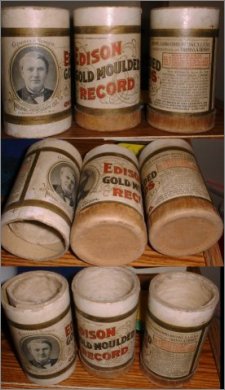Listen to & Download 1000s of Century-Old Pop & Folk Songs, Vaudeville Acts, Political Speeches, Audio Theater & More at No-Cost NOW
by www.SixWise.com
For those who have ever wondered what music sounded like
100 years ago, what Ernest Shackleton said about his Antarctic
explorations, or what Theodore Roosevelt sounded like giving
a speech, there is exciting news to be heard -- literally.
|

Now you can listen to historical speeches, music and
vaudeville acts that were once only stored on cylinders
like these.
|
Thanks to the University of California at Santa Barbara,
you can now listen to thousands of songs, speeches and other
performances, many of which have been inaccessible for nearly
100 years, and all for free.
Cylinders Turned Digital
The University has digitized nearly 6,000 cylinders, which
were used to record music in the late 19th and early 20th
centuries. Cylinders are about the size of a soda can and
were made from tin or wax and celluloid. Audio bits were recorded
onto grooves on the cylinders, which would then be inserted
into a player, wound up and played back by a stylus tracking
the grooves.
|
Real American Vaudeville

Check out this collection of acts from magicians, singers,
acrobats, actors and comedians who were popular from
1880-1930. For just 25 cents, you could take in eight
or 10 of these vaudeville acts in the late 19th century.
Today, you can hear them for free.
Listen
to American Vaudeville now!
|
When cylinders were first used, each one contained an original
version of a song or performance, as they could not be reproduced.
"There were no microphones, there were no mixers, there
were just people who -- through trial and error -- knew how
to position people around a recording horn," says Sam
Brylawski, a sound archivist and consultant to the Library
of Congress (which has about 25,000 cylinders of their own).
Interestingly, these first sound recorders have left a mark
on modern music; the cylinders could only hold three or four
minutes of audio, which may be why modern songs are rarely
longer than this.
If you had in your possession and wanted to play a cylinder
today, it could be done, but it would cost you. A modern cylinder
player, called an archeophone, costs $12,000.
Listen to Music, Speeches and Readings From a Simpler
Time
|
Hear Authentic Cakewalks and Rags
Cakewalks originated as a dance performed by black
slaves to parody their white owners. This musical form,
along with the similar Rags, involved syncopated beats
and march-like bass.
Want to hear this music that was hugely popular from
the 1890s through World War I?
Listen
to Cakewalks and Rags Now!
|
Because of cylinders' obscurity, the music and other audio
contained in them have been virtually inaccessible until now.
Those working on the project, named the Cylinder
Preservation and Digitization Project, expected some interest,
but have received more enthusiasm from the public than they
anticipated.
"We knew it would have popular appeal; I'm well acquainted
with the collector community, and there are a lot of fanatical
people interested in these things," said David Seubert,
a curator who manages the project. "But I didn't think
I'd be getting all these e-mails from random strangers thanking
me and our team or asking questions or offering to donate
records. It's just amazing."
|
Historical Speeches
Hear the speeches straight from the mouths of historical
figures like actress Sarah Bernhard, Theodore Roosevelt
and William Taft. Or, take in Len Spencer's famous "Advertising
Record," which was used to sell phonographs in
stores.
Listen
to Historical Speeches Now!
|
The goal of the project is not only to preserve these valuable
audio recordings from the past, but also to make them easily
accessible to the public. Since their Web site opened in November
2005, the pages have been viewed over 4.5 million times.
To hear some of these invaluable pieces of American history,
please peruse the links below.
Recommended Reading
LISTEN
UP! Exposure to Loud Noise May Cause Tumor & Other Health
Risks
The
Health Benefits of Dancing -- Including Specific Benefits
of Different Dances
Sources
The
Christian Science Monitor April 13, 2006